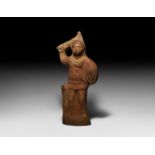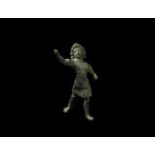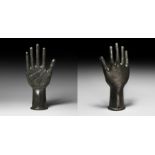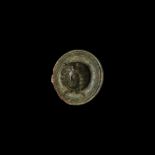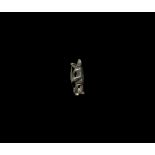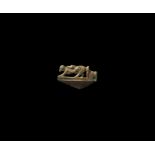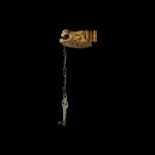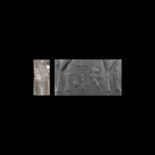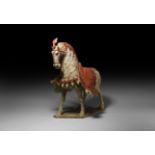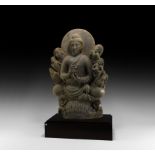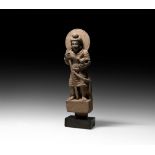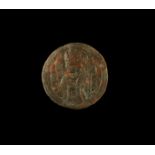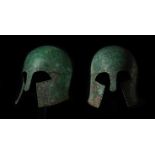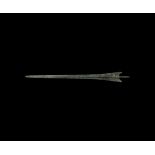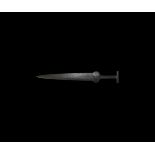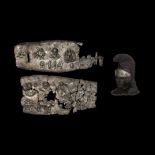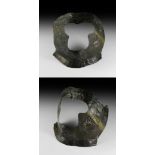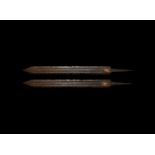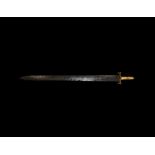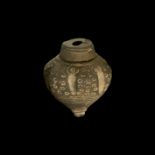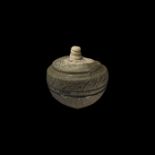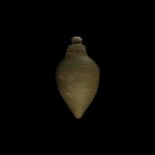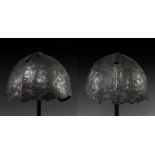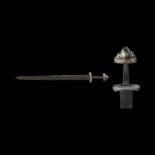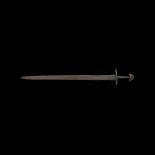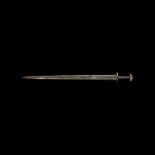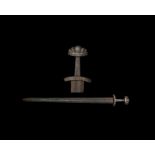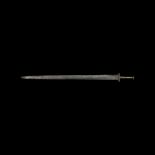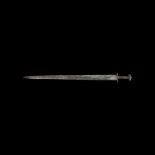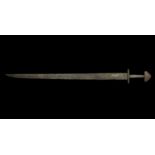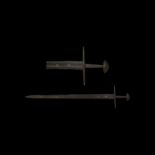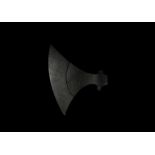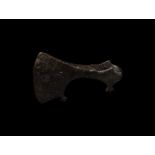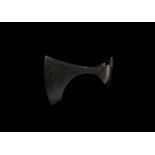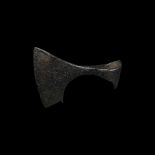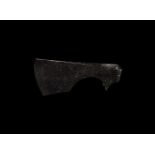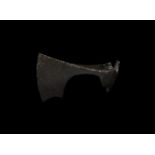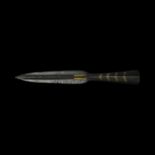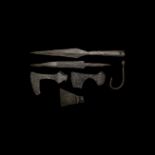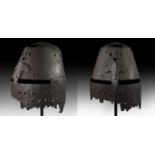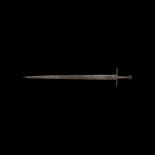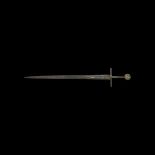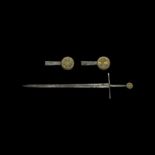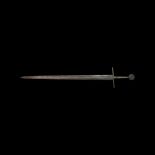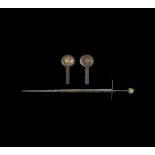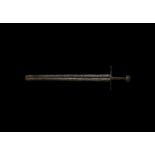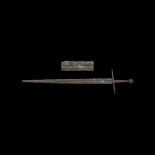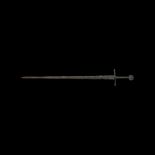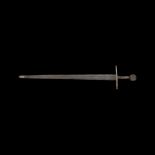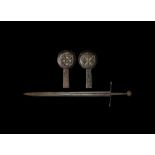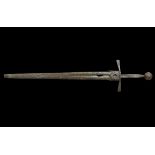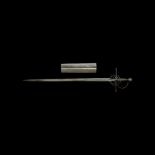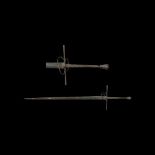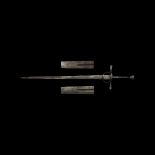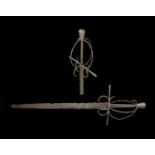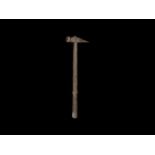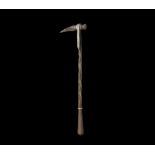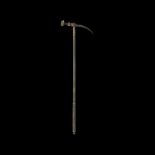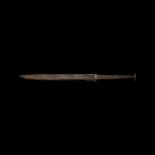Refine your search
Filtered by:
- Category
- List
- Grid
A subscription to the Price Guide is required to view results for auctions ten days or older. Click here for more information
1st century BC-1st century AD. A large and important terracotta oil lamp in the form of a statue of Mars dressed as a late Ptolemaic or Roman offi...
2nd-3rd century AD. A bronze statuette of a Roman warrior god in a striding stance, wearing a muscled armour (statos), over a thoracomacus with pe...
Roman Hand Signum Finial
1st-3rd century AD. A life-size solid bronze right hand in open position, the five fingers raised as a stop sign, the hand and finger lines well m...
Roman Gorgon Phalera
2nd-3rd century AD. A bronze military disc (phalera) in the shape of a Medusa head with snake hair and small wings to the brow, wide edge with an ...
Roman Tinned Gladiator Brooch
2nd century AD. A copper-alloy tinned fibula representing a gladiator of the secutor class, armed with a short dagger (sica), protected by a helme...
Roman Bone-Handled Knife
3rd-4th century AD. A bone and iron folding hunting knife (culter venatorius), the handle with an openwork representation of a mating scene betwee...
Roman Bone-Handled Folding Knife
4th century AD. A folding hunting knife (culter venatorius), the bone handle with an openwork representation of a crouched dog, allowing the inser...
539-330 BC. A rock crystal cylinder seal with a bearded worshipper on the left, wearing a pointed hood or cap and a long robe with a curved fringe...
Six Dynasties, 220-589 AD. A ceramic figure of a horse in advancing pose with scarlet and maroon painted detailing, plume to the chamfron. 3.1 kg,...
3rd-4th century AD. A carved schist stele depicting Buddha seated on a lotus-leaf dais, nimbus to the rear and six small nimbate figures flanking ...
Gandharan Armoured Soldier
2nd-4th century AD. A carved schist figurine of a standing nimbate male wearing a quilted corselet of soft material as well as armoured skirt and ...
Indus Valley Figural Stamp Seal
1st century BC-2nd century AD. A discoid bronze seal with facing portrait of a figure with tall headdress, cloak tied to the chest, both arms rais...
7th-6th century BC. An exceptionally well preserved bronze combat helmet of Archaic Corinthian type, with high bowl made from two separate metal s...
Greek 'Trojan' Sword Blade
12th-10th century BC. A bronze Troy type sword or rapier blade, leaf-shaped in plan; the midrib extending to the short tang with curved lateral ex...
Scythian Acinaces Short Sword
5th-4th century BC. An iron short sword with slender blade, rectangular grip with raised ribbed edges, lobed lower guard and rectangular pommel. ...
2nd-3rd century AD. Two sheet silver embossed plaques for a pseudo-Attic helmet, each with shaped edges, embossed around the edges with a double-p...
Roman Cavalry Sports Helmet Mask
Early 3rd century AD. A sheet bronze mask from a cavalry sports helmet of Heddernheim or Worthing Type with repoussé detailing; the lower edge a f...
Early 3rd century AD. A double-edged longsword (spatha) of Lauriacum Hromówka typology; well preserved blade, with four blood channels running thr...
5th-6th century AD. A double-edged cutting sword; the blade complete; the point is well preserved; both cutting edges show strong traces of use on...
9th-11th century AD. A hollow ceramic vessel with conical body, intended to be filled with explosive liquid and a wick, and used as a hand grenade...
9th-11th century AD. A hollow ceramic vessel with conical body, intended to be filled with explosive liquid and a wick, and used as a hand grenade...
9th-11th century AD. A hollow ceramic vessel with conical body, intended to be filled with explosive liquid and a wick, and used as a hand grenade...
Norman One-Piece Helmet
11th-12th century AD. A Western European iron conical helmet of Norman or German origin, with one-piece bowl, the fairly low central ridge taperin...
10th century-early 11th century AD. A double-edged Viking sword of Petersen Type L, variant Wheeler type VI, with complete blade, pattern-welded a...
10th-11th century AD. A fine double-edged sword with tapered pattern-welded blade, still retaining well-defined cutting edges and fullers, althoug...
Late 10th-early 11th century AD. A double-edged cutting sword, possible variant of type L, following the classification of Petersen (1919, pp.145f...
Viking Sword with Elaborate Hilt
10th century AD. An elaborate Petersen Type L or O variant double-edged sword; the straight blade pattern-welded tapering from a width of about 5c...
10th century AD. A double-edged cutting sword with copper wire decoration to the lower guard; both hilt and blade are in a fair state of preservat...
Early 11th century AD. A double-edged cutting sword of Oakeshott type XII with inlaid silver and copper wire decoration on the hilt; both hilt and...
9th-early 10th century AD. A rare single-edged Viking sword of C type following the classification of Petersen (1919, pp.66ff), with a finely tape...
Mid 10th-mid 11th century AD. A western European long double cutting sword with broad tapering blade with evidence of its use on the battlefield; ...
Viking Danish Broad Axehead
9th-11th century AD. A substantial iron fighting axehead with slender curved blade with reinforced cutting edge, triangular socket with small rect...
9th-12th century AD. An iron axehead with short curved blade, square chin with trefoil spur to the lower edge, perforation to the blade; socket wi...
Large Viking Bearded Axehead
9th-11th century AD. An iron axehead with triangular-section blade and narrow neck widening to a curved edge with curved chin and spur, triangular...
Viking Bearded Axehead
9th-11th century AD. An iron axehead with triangular-section blade widening to a curved blade with straight chin and spur, large socket with trian...
Viking Bearded Axehead
9th-11th century AD. A light iron axehead with triangular-section blade with curved edge and straight chin, triangular spurs to the socket. 315 g...
Viking Bearded Axehead
9th-11th century AD. An iron axehead with triangular-section blade, narrow neck widening to a broad edge with curved chin, socket with triangular ...
Viking Laten-Inlaid Spearhead
9th-10th century AD. An iron spearhead comprising an octagonal-section tapering socket developing to a thick midrib for the slender willow-leaf bl...
9th-11th century AD. A mixed group of iron objects comprising: two axeheads each with a square chin to the slightly curved blade, one with a hamme...
Medieval German Great Helm
Mid 14th century AD. A German great helm of later type with the lower part missing, but still visible in its original shape; comprising five plate...
Mid 10th-mid 11th century AD. An elegant, finely tapering blade with well-formed fullers, running down to within 23cm of the point, the cutting ed...
11th-mid 12th century AD. A Western Middle Age iron sword, probably from Germany, with two-edged blade, tapering profile, appreciable fuller, para...
Early 13th-mid 14th century AD. A Western Middle Age iron longsword, from Scotland or possibly France, of Oakeshott's Type XIIa, cross style 1, po...
Early 13th century AD. An iron longsword of Oakeshott's Type XIIIA, cross style 1, pommel type H; a 'Bastard' sword (sword that can also be used w...
Medieval Hand-and-a-Half Sword
Early 14th century AD. A Western Middle Age iron half and hand sword from Germany, of Oakeshott's Type XIIIA, cross style 1 (in early form, spike-...
Early-late mid 14th century AD. A Western Middle Age iron longsword from Italy, of Oakeshott's Type XV.A, cross style 8, pommel style J (recessed)...
13th century AD. A double-edged iron sword of Oakeshott's Type XII, with broad, flat, evenly tapering blade, unfortunately broken at three-quarter...
Mid 11th-mid 12th century AD. A Western Middle Age double-edged iron sword, from Central Europe, of Petersen type X-Oakeshott type Xa, with tapere...
Medieval Single-Handed Sword
Early 14th century AD. A Western Middle Age iron longsword, possibly from Italy, of Oakeshott's Type XVI.2, cross style 2, pommel style K, showing...
Medieval Single-Handed Sword
Mid 11th-mid 13th century AD. A Western Middle Age iron sword of Oakeshott type XI or XII, with two-edged blade, gently tapering profile with roun...
Early 14th century AD. An English or German iron longsword of Oakeshott's Type XIIIA, a Bastard sword (sword that can be used also with two hands)...
Later 13th century AD. A double-edged iron longsword of Oakeshott's Type XII (Oakeshott, 1991, p.105), the broad, flat, evenly tapering blade is t...
Early 16th century AD. A Western European rapier of possible Italian manufacture, with 16th-century open basket-hilt sword, still fitted with the ...
Tudor Era Hand-and-a-Half Sword
Mid 16th century AD. A German Renaissance 'hand-and-a-half' or 'Bastard' sword, with double ring guard, double edged broad blade; this gradually t...
Tudor Era Hand-and-a-Half Sword
Mid 16th century AD. A German Renaissance 'hand and a half' or 'Bastard' sword, with ring guard, double-edged broad blade, lenticular in section, ...
Tudor Era Double-Handed Rapier
Mid 16th-early 17th century AD. A rapier of possible Spanish or Italian manufacture; the open basket-hilt sword, fitted with the blade, has straig...
Medieval War Hammer
15th century AD. An iron war hammer with square-section haft, head with flanged striking face, spike to the rear, haft with collar and hole for st...
16th-17th century AD. A war hammer or Nazdiak of Polish origin, the head composed of two pieces; the twisted shaft made of solid iron, and the hea...
Tudor Era Renaissance War Hammer
Late 16th century AD. A Western European war hammer (reiterhammer) made of two pieces, the iron shaft and the head; the head made as a single soli...
Medieval Rondel Dagger
14th-15th century AD. A single-edged dagger with slender piled-iron blade and integral tang, ellipsoid baluster, disc pommel. 174 grams, 42cm (16...

